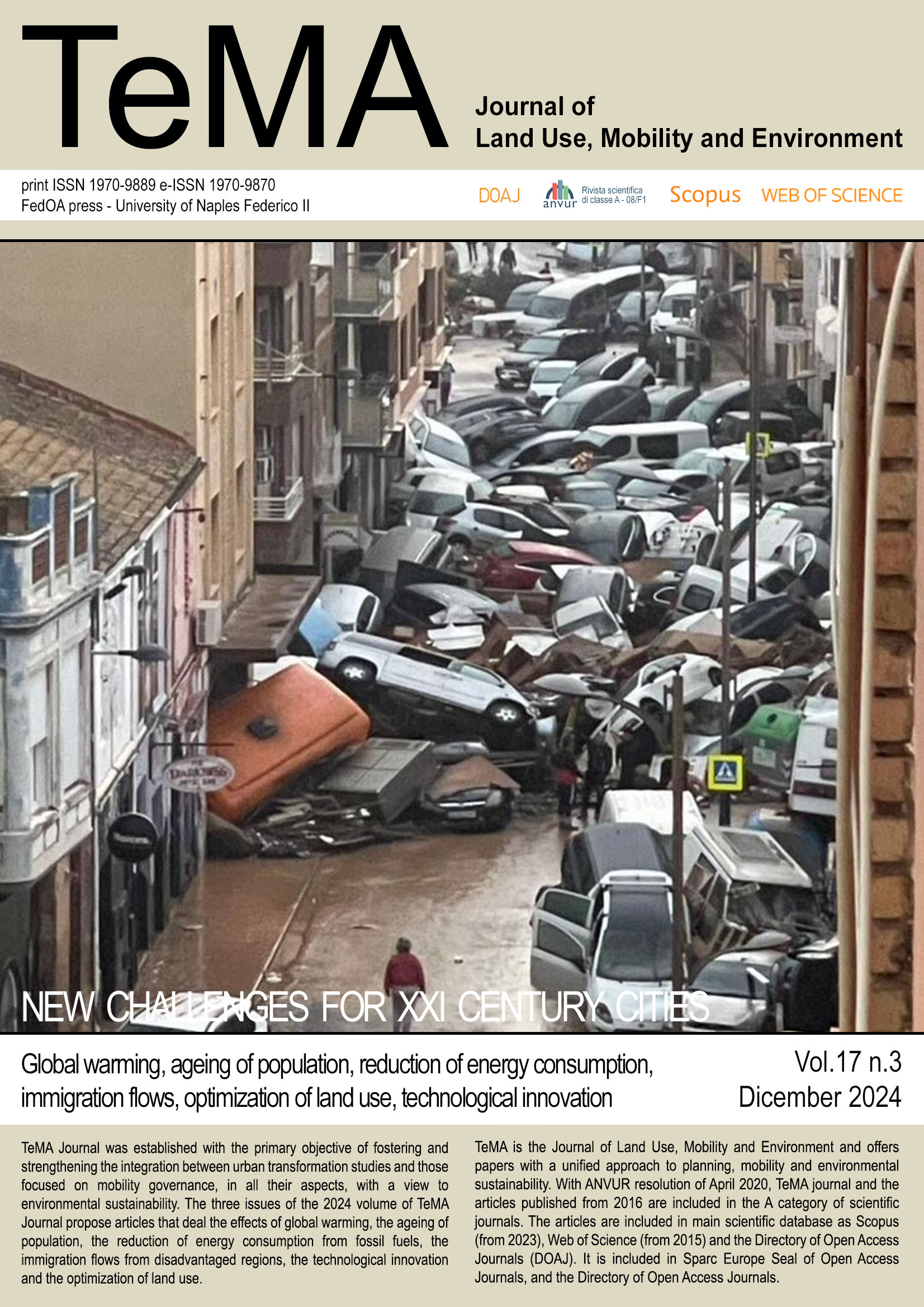Strategies and instruments for active mobility: the main Italian policies
Abstract
Starting from the relationship between urban planning and mobility management, TeMA has gradually expanded the view of the covered topics, always remaining in the groove of rigorous scientific in-depth analysis. This section of the Journal, Review Notes, is the expression of continuously updating emerging topics concerning relationships between urban planning, mobility and environment, through a collection of short scientific papers written by young researchers. The Review Notes are made of four parts. Each section examines a specific aspect of the broader information storage within the main interests of TeMA Journal. In particular, the Urban strategies, programmers and tools section presents the different strategies and tools for active mobility implemented internationally. This work aims to highlight the various actions undertaken at national and local level to promote the spread of active mobility in Italy, providing a general overview of the tools and strategies adopted and also presenting concrete examples of solutions implemented in some cities. The numerous positive experiences at local level allow us to highlight the attention of Italian cities to reduce dependence on the car (and motorcycle) mode in daily travel, in favor of lower-impact modes of transport This trend of promoting active travel (on foot and by bicycle), which is more ecological and healthy, could contribute to achieving the goal of improving the quality of urban environments and the quality of life of people.
Downloads
References
Busi, R. (2023). Il divenire della disciplina urbanistica: il contributo di Roberto Busi. TeMA - Journal of Land Use, Mobility and Environment, (1), 9-35. https://doi.org/10.6093/1970-9870/9734
Cecchini, A. (2023). Il divenire della disciplina urbanistica: il contributo di Arnaldo Cecchini. TeMA - Journal of Land Use, Mobility and Environment, (1), 37-59. https://doi.org/10.6093/1970-9870/9744
Ciriann, F., Comi, A. & Luongo, A. (2022). A sustainable approach for planning of urban pedestrian routes and footpaths in a pandemic scenario. TeMA - Journal of Land Use, Mobility and Environment, 15 (1), 125-140. https://doi.org/10.6093/1970-9870/8629
Commission Recommendation (EU) 2023/550. Commission Recommendation (EU) 2023/550 of 8 March 2023 on National Support Programmes for Sustainable Urban Mobility Planning (notified under document C(2023) 1524). Retrieved from: https://eur-lex.europa.eu/legal-content/EN/TXT/?uri=CELEX%3A32023H0550
D’Amico, A. (2024). Strategies and instruments for active mobility: a European overview. TeMA - Journal of Land Use, Mobility and Environment, 17 (2), 363-371. https://doi.org/10.6093/1970-9870/10940
EC (2022). Study on New Mobility Patterns in European Cities. Task A: EU Wide Passenger Mobility Survey. Retrieved from: https://transport.ec.europa.eu/system/files/2022-12/2022%20New%20Mobility%20Patterns%20in%20European%20Citie s%20Task%20A%20Executive%20summary.pdf
EU Urban Mobility Observatory (2022). Sustainable Urban Mobility Plans - Member State profiles – Italy. Retrieved from: https://urban-mobility-observatory.transport.ec.europa.eu/sustainable-urban-mobility-plans/member-state-profiles/italy_en
Gaglione, F. & Ayiine-Etigo, D. A. (2022). Accelerate urban sustainability through policies and practices on the mobility system in Italy. TeMA - Journal of Land Use, Mobility and Environment, 15 (3), 549-553. https://doi.org/10.6093/1970-9870/9413
Gargiulo, C. & Sgambati, S. (2022). Active mobility in historical districts: towards an accessible and competitive city. The case study of Pizzofalcone in Naples. TeMA - Journal of Land Use, Mobility and Environment, 31-55. https://doi.org/10.6093 /1970-9870/8395
Italian SUMPs Observatory. Retrieved from: https://www.osservatoriopums.it/
MIT (2022). Vademecum per la redazione del Piano Urbano di Mobilità Sostenibile (PUMS). Retrieved from: https://www.mit.gov.it/documentazione/vademecum-per-la-redazione-del-piano-urbano-di-mobilita-sostenibile-pums
Metropolitan City of Milano (2021). Cambio: il Progetto Biciplan. Retrieved from: https://www.cittametropolitana.mi.it /portale/news/Cambio-il-Progetto-Biciplan/
Municipality of Parma (2024). Sustainable Urban Mobility Plan. Retrieved from: https://www.comune.parma.it/it/ argomenti/mobilita-sostenibile/pums
Padovanet (2022). Metrominuto Padova. La città al passo. Retrieved from: https://www.padovanet.it/informazione /progetto-metrominuto-padova-la-citt%C3%A0-al-passo
Regione Piemonte (n.n). Progetto BIP4MaaS (BIP for Mobility as a Service). Retrieved from: https://www.regione. piemonte.it/web/temi/mobilita-trasporti/bip-biglietto-integrato-piemonte/progetto-bip4maas-bip-for-mobility-as-service
SUMP of Bolzano (2022). Sustainable Urban Mobility Plan. Retrieved from: https://opencity.comune.bolzano.it/Documenti-e-dati/Documenti-tecnici-di-supporto/PUMS-Piano-urbano-della-Mobilita-Sostenibile#descrizione
TEN-T Regulation (2024). Regulation (EU) 2024/1679 of the European Parliament and of the Council of 13 June 2024 on Union guidelines for the development of the trans-European transport network, amending Regulations (EU) 2021/1153 and (EU) No 913/2010 and repealing Regulation (EU) No 1315/2013 (Text with EEA relevance). Retrieved from: https://eur-lex.europa.eu/eli/reg/2024/1679
Copyright (c) 2024 TeMA - Journal of Land Use, Mobility and Environment

This work is licensed under a Creative Commons Attribution 4.0 International License.
Authors who publish in this journal agree to the following:
1. Authors retain the rights to their work and give in to the journal the right of first publication of the work simultaneously licensed under a Creative Commons License - Attribution that allows others to share the work indicating the authorship and the initial publication in this journal.
2. Authors can adhere to other agreements of non-exclusive license for the distribution of the published version of the work (ex. To deposit it in an institutional repository or to publish it in a monography), provided to indicate that the document was first published in this journal.
3. Authors can distribute their work online (ex. In institutional repositories or in their website) prior to and during the submission process, as it can lead to productive exchanges and it can increase the quotations of the published work (See The Effect of Open Access)

